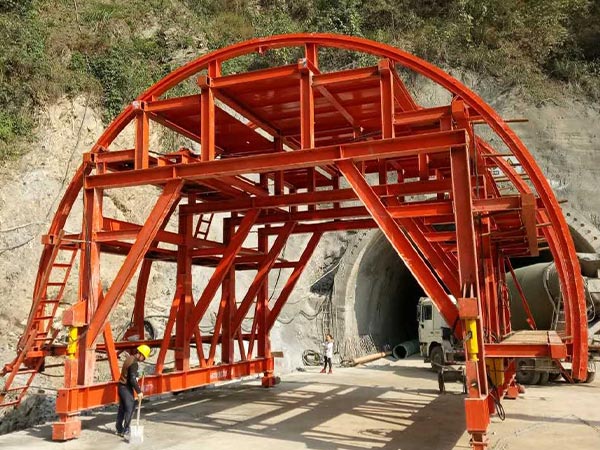What are the factors that affect the curing effect of tunnel lining concrete?
The tunnel lining concrete maintenance can be divided into two types in terms of technology: water spray maintenance, spray maintenance and curing agent maintenance. Sprinkler maintenance refers to the use of water pipes or sprinklers to directly spray the maintenance water onto the concrete surface for maintenance, which can be operated manually or by spraying the lining trolley. Spray curing refers to the method of using atomizing equipment to atomize the curing water and then curing the concrete.
Manual sprinkling maintenance has low requirements for equipment, but the frequency, amount and duration of sprinkling water are subjective. Since the spraying trolley is carried out in a non-enclosed space in the tunnel, a large amount of maintenance water is retained and lost in the air when it is sprayed.
Although the curing agent can form a relatively complete film with isolation on the surface of the concrete, it is difficult to achieve a uniform ideal state in the spraying effect; at the same time, as the organic matter continues to volatilize, due to the inevitable uneven spraying, Weak areas will be formed in the areas where the spraying is thinner, and the concrete in these weak areas will undergo internal and external moisture migration and evaporation loss.

Factors affecting concrete curing effect
Cement concrete refers to the artificial stone formed by mixing water, aggregate and cement and then hardening after hydration reaction. Cement is a hydraulic cementing material. With the participation of water, new cementing compounds are formed, and then slowly harden into cement stone. This process is called hydration. However, after the concrete is poured, due to the humidity difference between the concrete and the air, the moisture inside the concrete has to evaporate and migrate to the external environment through the surface, thereby affecting the moisture required for the hydration of the concrete itself.
In order for the concrete hydration reaction to proceed normally, after the concrete is poured, it is necessary to maintain a temperature and humidity environment conducive to the cement hydration reaction for a considerable period of time. The curing of concrete is to create a curing measure that is conducive to the hydration reaction of cement. In addition, higher-quality concrete also requires good curing conditions in the early stage of hardening.
Curing temperature
Curing temperature is one of the most important factors affecting the performance of concrete. Because high temperature can accelerate the violent degree of cement hydration reaction, the higher the curing temperature, the faster the strength of the concrete will increase. Studies have shown that there is a certain temperature critical value. When the temperature is lower than this value, the hydration reaction of cement basically stops. Therefore, when the ambient temperature is lower than this value, the strength of the coagulant will no longer increase. When the temperature is lower than 0°C, the concrete will undergo frost damage due to the freezing of internal moisture. In addition, it is not that the higher the curing temperature, the more beneficial it is to the strength growth of the concrete. This is because the excessively high environmental temperature in the early stage will cause the strength of the later concrete to grow slowly or even not.

Curing humidity
The degree of hydration of cement has an important influence on a series of mechanical properties and durability of concrete. The existence of free water in the capillary tube is an important prerequisite for cement hydration. As the cement hydration reaction continues, the hydration products gradually fill the capillary voids. In this process, the water pressure in the capillary voids continues to increase, and the increasing water pressure promotes the migration of water to the surface of the concrete. When the environment is very dry At that time, there was an early large evaporation of water. The rapid evaporation of water will reduce the solubility of the reactants in the capillary voids to below the saturation level, thereby hindering the normal hydration reaction of cement. When the evaporation rate of moisture on the surface of concrete is greater than the rate of moisture migration through the capillary pores, the concrete will undergo plastic shrinkage and cracking, causing a series of concrete quality problems.
Curing time
Cement clinker is composed of different mineral components, and the hydration rate of different mineral components is significantly different. For ordinary Portland cement, according to the speed of hydration rate, it has the following rules: tricalcium aluminate> tetracalcium aluminate ferrite> tricalcium silicate> dicalcium silicate. Law: dicalcium silicate> tricalcium silicate> tetracalcium aluminate> tricalcium aluminate. It can be seen from the above that the different mineral components of cement and their proportions are important for the setting time, early strength and late strength of cement. Influence. Since the hydration reaction of cement will last for a long time, during the whole process of cement hardening, both the early and late curing are very important and indispensable.
In addition, curing time is another important factor that affects the performance of concrete. The increase in the strength of the concrete is achieved in a curing environment where the temperature is constantly changing. Under general conditions, the strength of concrete generally increases with the increase of the curing age. But in different stages, the growth rate is different, and the early strength increases faster with age. The 3 d strength of the concrete can reach about 50% of the 28 d strength, the 7 d strength can reach about 67% of the 28 d strength, and the strength increase after 28 d is gradually slow.


